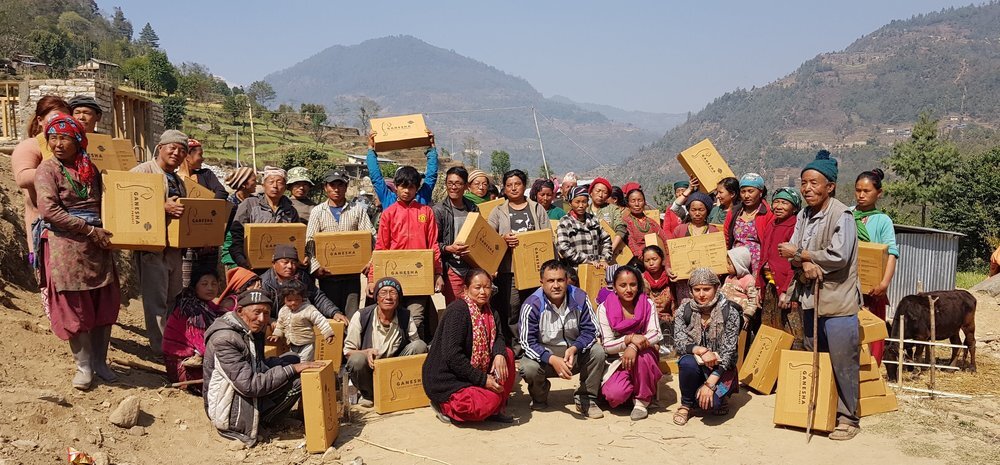Summary Report of Ganesha Humanitarian Stove Field Testing in Nepal
Ganesha Stove Distribution in Gokulganga, Ramechhap, Nepal, March 2018. Villagers carried the flat-packed stoves into their village above the road.
EXECUTIVE SUMMARY
USABILITY SURVEY REPORT OF GANESHA COOKSTOVE PILOT PROJECTS IN NEPAL
SUPPORTED BY THE GANESHA COOKSTOVE PROJECT
BASUDEV UPADHYAY, PRINCIPAL INVESTIGATOR, JULY 1, 2019
Download full report here
In Nepal, official figures show that 64% of households rely on firewood for cooking, and just 26% have access to clean cooking solutions such as improved biomass cookstoves. The Ganesha Cookstove Project is aimed at creating a low-cost, easy-to-transport stove that not only meets international standards for efficiency and emissions, but also meets the cooking needs of villagers in Nepal.
Usability of the Ganesha biomass cookstove was measured at six different sites in Nepal, and compared to the usability of existing traditional stoves, LPG (gas) stoves, and other stoves in use. A total of 340 Ganesha stoves were distributed, primarily to disadvantaged villagers, and usability surveys were conducted 3 weeks to 6 months after users received the stove. Very little to no training was given in the use of the stove.
A usability survey was developed based upon research by the Centre for Rural Technology Nepal (CRTN), which determined 8 key factors in cookstove usability. Users were asked to rank their stoves, including the Ganesha stove, on those factors. The survey also asked questions to determine hours of use, fuel consumed, and the kinds of food cooked on different stove types. To determine stove acceptance and behavior change, the survey asked if users would buy the Ganesha stove, and if so what they would pay. They were then asked what they would cook on the stove, and how much it would cost to use, and what they liked. Open-ended comments and suggestions were then solicited.
A typical kitchen in Dhorpatan with multiple cooking stoves including Ganesha Cookstove (GCS) at left and traditional cookstove (TCS) in back, and a variety of cooking pots. Shown behind the cook is an alcohol still.
Demographics: 98% of respondents were female, in households that mostly had a family size of 4 to 6 people.
Cooking practices: Respondents cooked 2 to 3 meals for their household each day, and also prepared warm or hot animal fodder in large flat-bottom pots once per day. Foods cooked included dhindo, a dish made of corn or millet flour that requires vigorous stirring; rice, legumes, flatbreads, vegetables, potatoes, and dairy products. Alcohol making was also common, and used large stills. Typical cooking pots included a semi-circular bowl called karaai for boiling and frying vegetables, and sometimes for making dhindo; a heavy round-bottomed pot called kasaudi; pressure cookers; and tea kettles. The overwhelming majority (93.5%) used traditional open fires for almost every cooking task prior to these pilot projects. Where respondents had LPG stoves, they used them for making tea and quick-serve meals.
Comparison of usability factors: The 8 key factors identified by CRTN included 1) Fuel Saving, 2) Time Saving, 3) Smoke Reduction, 4) Multi-Purpose, 5) Ease of Use, 6) Safe to Use, 7) Keeps Kitchen Clean, and 8) Looks Nice. The CRTN study and others showed that three attributes – Smoke Reduction, Time Saving, and Fuel Saving – were essential attributes of a clean cookstove. Users ranked the Ganesha stove highest for 2 of these factors: Fuel Saving and Time Saving. They also ranked the Ganesha stove highest for Multi-Purpose and Safe to Use. They did not rank their traditional stoves highest for any of the 8 factors. LPG stoves were ranked highest for Smoke Reduction, User-Friendliness, Keeps Kitchen Clean, and Looks Nice.
Cost of cooking: Fuel costs varied widely among the 6 pilot project areas. Based on user reporting and subsequent calculations, traditional stoves were the most expensive to use, both overall and per hour of use. Ganesha stoves were found to be significantly cheaper to use, with about half the fuel consumption per hour on average. LPG stoves were well-loved by respondents, and were not reported to be more expensive to use, but were seldom used for big cooking tasks. Users considered them to be “luxury items,” and used LPG only during emergencies, such as hosting unexpected guests, or during the rainy season when fuelwood was wet or unavailable.
Willingness to buy: 93.3% of respondents said they would buy a Ganesha stove if needed and available in the future. When asked what they would pay, most users (69%) said they would pay NPR 500 to 1000 (US$5 to $10). Another 28% would pay more than NPR 1000. This should serve as an indication of the subsidy level needed to meet users’ ability and willingness to pay.
What they cooked on the Ganesha stove: Users said they used the Ganesha stove to cook all of their normal foods, including rice, dal (lentils), beans, vegetables, potatoes, roti (flatbreads), tea, boiling milk, fish, and dhindo (a corn or millet paste that requires vigorous stirring to cook).
User preferences: When asked to provide open-ended comments and suggestions about the Ganesha stove, the most common responses were 1) faster cooking (80%), 2) uses less firewood (72%), 3) fewer emissions (71%), and 4) portability (53%). Users suggested that the stove be made a) to accommodate a bigger pot, b) with a shorter combustion chamber; and c) with a larger opening for wood.
Links to individual area reports:
Usually men do not cook. But if there is a better way of cooking, he does. Anjali Majhi making good use of corn cobs in Majhigaun.



